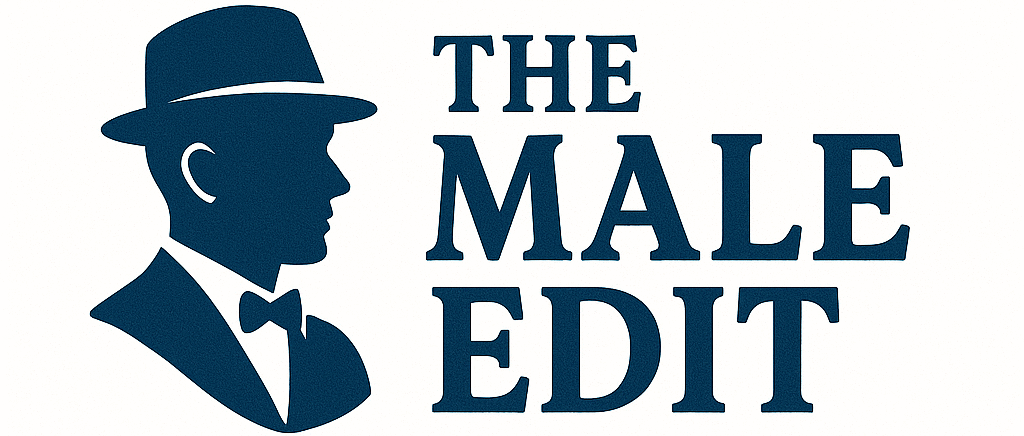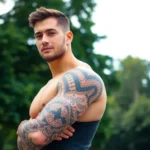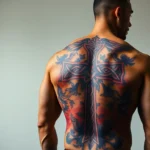Mexican tattoos offer an incredible way to honor rich cultural heritage while making a bold artistic statement. We’ve seen these powerful designs gain massive popularity among men who want meaningful ink that tells a story of tradition, strength, and cultural pride.
From intricate Aztec warriors and sacred Day of the Dead imagery to vibrant sugar skulls and ancient Mayan symbols, Mexican-inspired tattoos deliver striking visuals with deep symbolism. These designs don’t just look impressive – they connect us to centuries of artistic tradition and spiritual meaning that resonates far beyond the surface.
Whether you’re drawn to the fierce energy of pre-Columbian art or the colorful celebration of Mexican folk culture, we’ll explore the most compelling tattoo ideas that capture Mexico’s artistic soul. Get ready to discover designs that’ll transform your skin into a canvas of cultural storytelling and masculine power.
Traditional Aztec and Mayan Designs for Masculine Appeal
Ancient Mesoamerican civilizations offer powerful symbols that create striking tattoos with deep cultural significance. These designs blend spiritual meaning with warrior aesthetics that appeal to men seeking meaningful body art.
Eagle Warriors and Jaguar Symbols
Eagle warriors represent the elite Aztec military class known for their fierce combat skills and spiritual dedication. These designs typically feature detailed featherwork, ceremonial headdresses, and powerful facial expressions that convey strength and honor. We see these tattoos commonly placed on the chest, back, or upper arm to showcase their impressive detail and symbolism.
Jaguar symbols embody the night warrior class and connect to themes of stealth, power, and connection to the underworld. The jaguar’s spotted coat translates beautifully into tattoo designs with intricate dot work and shading techniques. Artists often incorporate jade green accents to represent the precious stone associated with these sacred animals in Aztec culture.
Combined eagle and jaguar designs create ever-changing pieces that represent the duality of day and night warriors. These tattoos work exceptionally well as large chest pieces or full back designs where the artist can showcase both creatures in battle or ceremonial poses.
Ancient Calendar and Geometric Patterns
Aztec calendar stones provide intricate geometric patterns that create visually stunning tattoos with mathematical precision. The famous Aztec sun stone features concentric circles, glyphs, and symbolic representations of time cycles that translate perfectly to circular shoulder or back pieces. These designs often incorporate the central sun god face surrounded by day signs and cosmic symbols.
Mayan geometric patterns focus on stepped pyramid designs, interlocking squares, and angular line work that represents their advanced understanding of astronomy and mathematics. We recommend these patterns for men who appreciate clean lines and symmetrical designs that can wrap around arms or legs.
Step fret patterns, known as “grecas,” create borders and accent elements that complement larger Mesoamerican tattoo designs. These geometric elements work well as standalone pieces on forearms or as connecting elements between larger traditional designs.
Feathered Serpent Quetzalcoatl Representations
Quetzalcoatl combines the earth power of serpents with the sky domain of feathered birds to create one of the most revered deities in Mesoamerican culture. These tattoos typically feature long, flowing serpent bodies covered in detailed feather work that creates ever-changing movement across the skin. The feathered serpent works exceptionally well as a wraparound design for arms, legs, or torso pieces.
Wind god representations of Quetzalcoatl emphasize flowing lines and spiral patterns that symbolize breath, life force, and creative energy. These designs often incorporate turquoise and gold color schemes that reflect the precious materials associated with this deity in ancient temples.
Temple carvings inspire modern Quetzalcoatl tattoos with stone-like textures and architectural elements that frame the serpent figure. Artists achieve this effect through careful shading techniques that give the tattoo a three-dimensional carved appearance, making it appear as though the design emerges from the skin itself.
Day of the Dead Skull Tattoos with Cultural Authenticity
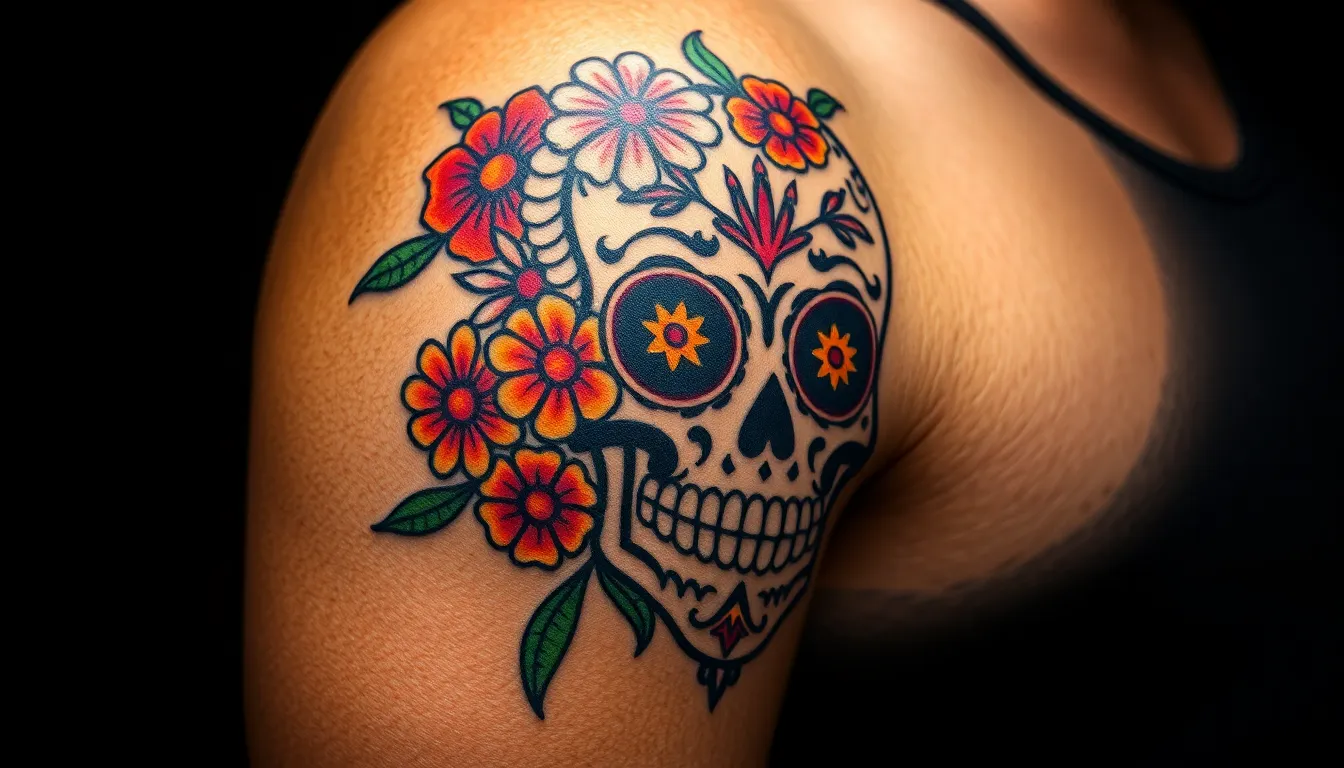
These powerful tattoos originate from the Mexican holiday that honors deceased loved ones and celebrates the eternal connection between life and death. Day of the Dead designs offer men authentic cultural symbolism rooted in Indigenous and Spanish traditions that span centuries.
Sugar Skull Designs with Intricate Details
Sugar skull tattoos feature highly detailed, ornate decorations that symbolize the souls of the departed in Mexican culture. Bright colors and elaborate patterns distinguish these designs, often integrating marigolds (cempasúchil), dots, swirls, and lace-like filigree that create visually captivating pieces. Artists typically use neo-traditional, watercolor for vibrancy, or black and grey styles for classic solemnity when creating these meaningful tattoos.
Colorful patterns and floral motifs, especially marigolds, are believed to guide spirits back to the living industry according to Mexican tradition. These designs can incorporate names or dates as personal tributes, making each tattoo a unique memorial piece. Flowers, candles, and traditional decorative elements transform the basic skull shape into an artistic celebration of remembrance and cultural heritage.
Calavera Portrait Styles
Calavera portraits blend realistic or stylized faces painted with skull makeup, representing a direct homage to Day of the Dead rituals. These tattoos balance lifelike portraiture with symbolic skeletal representation, creating powerful memorial pieces that honor exact individuals. Artists often include roses, candles, and traditional Mexican attire to enhance the cultural authenticity of these designs.
Human features merge seamlessly with skull imagery in these portraits, creating a striking visual that celebrates both life and death. Traditional face paint patterns used during Día de los Muertos celebrations inspire the decorative elements around the eyes, cheeks, and mouth areas. Many men choose calavera portraits as personalized memorial tattoos that capture the essence of loved ones while honoring Mexican cultural traditions.
Dia de los Muertos Scene Compositions
Complex tattoo compositions depict entire Day of the Dead scenes, including altars (ofrendas), marigold garlands, candles, and dancing skeletons that tell complete cultural stories. These designs narrate the festive and spiritual customs of the holiday, reflecting joy, remembrance, and cultural storytelling through detailed imagery. Large-scale tattoos connect the wearer’s personal memories with broader cultural celebrations of life and death.
Elaborate scenes showcase dancing skeletons, traditional altars adorned with photographs and offerings, and vibrant marigold displays that capture the holiday’s essence. Artists create these compositions to include multiple elements like papel picado, sugar skulls, candles, and traditional Mexican symbols that work together as unified storytelling pieces. Such comprehensive designs serve as ever-changing tributes to ancestors while celebrating the rich traditions of Mexican Day of the Dead customs.
Mexican Flag and Patriotic Symbol Tattoos
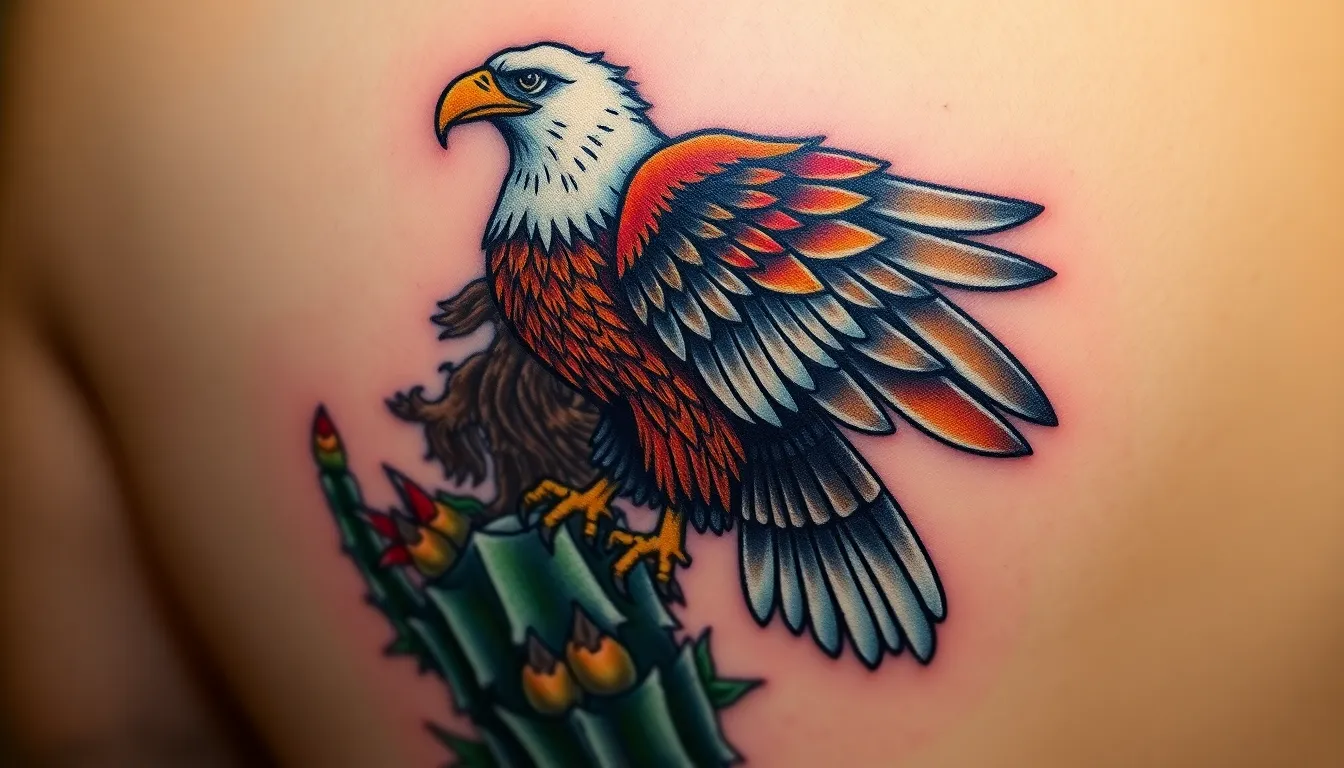
Patriotic Mexican tattoos offer men powerful ways to showcase national pride through iconic symbols that represent centuries of heritage and cultural identity.
Eagle Perched on Cactus Designs
Eagle perched on cactus tattoos draw directly from the legendary founding of Tenochtitlán, where Aztec gods guided their people to establish Mexico City at the exact spot where this divine sign appeared. We see these designs featuring bold, detailed eagles with intricate feather work that captures the majestic power of Mexico’s national bird. Artists often incorporate naturalistic prickly pear cactus elements beneath the eagle, creating compositions that tell the complete story of Mexican origins.
Modern interpretations blend traditional symbolism with contemporary tattoo artistry, allowing men to express their connection to Mexican identity through striking visual narratives. Detailed feather textures and realistic cactus spines add depth to these designs, making them standout pieces that command attention. Bold black and gray shading techniques emphasize the eagle’s strength and dominance in these powerful representations.
Tricolor Flag Integration Ideas
Tricolor flag elements transform ordinary tattoo designs into vibrant celebrations of Mexican patriotism through strategic use of green, white, and red coloring. We recommend incorporating these colors as flowing banners that wrap around cultural icons like eagles, Aztec symbols, or religious imagery. Flag integration works particularly well as background elements that frame larger compositions without overwhelming the primary design focus.
Creative approaches include stylized flag ribbons that connect multiple tattoo elements, color highlights that accent exact design features, and abstract interpretations that suggest the flag’s presence through strategic color placement. Ever-changing compositions show the flag flowing behind symbolic images, creating movement and patriotic energy within the overall design. Artists often blend the tricolor scheme with other Mexican cultural elements to create cohesive, meaningful artwork.
National Coat of Arms Interpretations
National coat of arms tattoos combine the eagle, cactus, and serpent into complete symbolic narratives that represent triumph, resilience, and Mexican unity. We find these designs particularly compelling because they tell the full story of Mexico’s founding legend, with the eagle grasping a serpent in its beak and talon while perched on the sacred cactus. Traditional interpretations maintain the classical heraldic style found on the official flag and government documents.
Contemporary artists modernize coat of arms designs by incorporating Aztec motifs, indigenous patterns, and stylized elements that deepen the cultural narrative beyond simple patriotic display. These tattoos work exceptionally well as chest pieces, back panels, or shoulder designs where the intricate details can be properly showcased. Blending techniques allow artists to merge the coat of arms with other Mexican cultural symbols, creating personalized interpretations that honor both national pride and individual heritage connections.
Realistic Portrait Tattoos of Mexican Icons
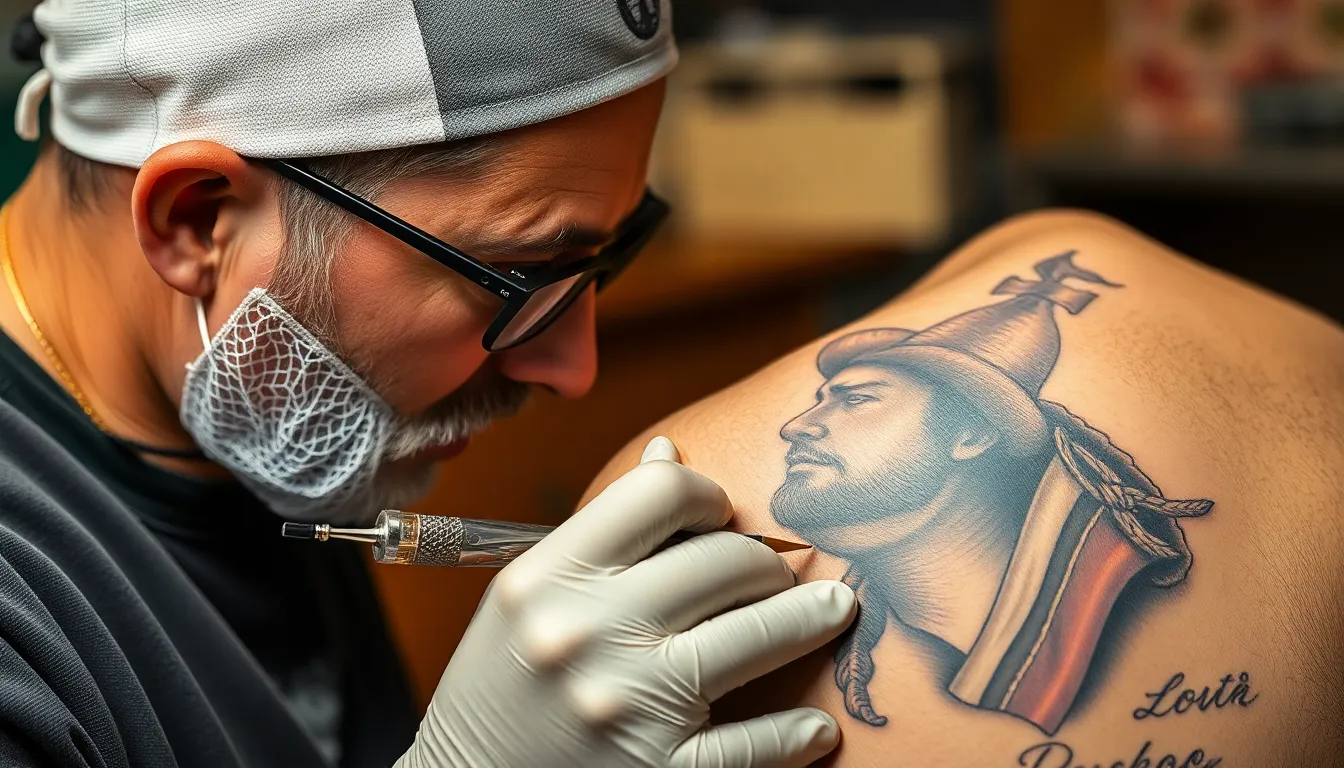
Portrait tattoos capture the detailed likeness of iconic Mexican figures using black and gray realism techniques. We see these designs honor cultural heroes through lifelike representations that convey strength and historical reverence.
Revolutionary Heroes Like Pancho Villa
Pancho Villa tattoos symbolize rebellion and national pride through detailed portrait work. Revolutionary leaders like Villa and Emiliano Zapata appear in traditional attire, often accompanied by rifles or horses that reflect their legendary status. Artists create these portraits using black and gray realism techniques that capture every facial detail and expression.
Custom Pancho Villa designs blend Chicano art styles with Aztec motifs for enhanced cultural depth. Platforms like Etsy offer personalized revolutionary hero tattoos, while Instagram portfolios showcase diverse artistic interpretations from traditional to modern styles. These tattoos often incorporate symbolic elements like sombreros, bandoliers, and revolutionary quotes that strengthen the historical narrative.
Skilled tattoo artists focus on capturing the weathered faces and determined expressions of these heroes. Portrait work requires precise shading techniques to create realistic skin textures and facial features. We recommend choosing artists who specialize in black and gray realism for the most authentic representations of these historical figures.
Cultural Figures and Luchador Masks
Luchador masks represent Mexican wrestling culture through bold, colorful designs that embody mystery and strength. These tattoos feature intricate mask patterns with vibrant colors like gold, red, and blue that reflect traditional lucha libre aesthetics. Artists often combine these masks with Aztec patterns or indigenous motifs to create deeper cultural connections.
Cultural figures like Frida Kahlo celebrate Mexican artistic heritage through detailed portrait work. Musicians, artists, and other cultural icons appear in tattoos that honor their contributions to Mexican culture. These designs typically incorporate elements related to their artistic work, such as paintbrushes for Frida or musical instruments for famous musicians.
Wrestling mask tattoos capture the theatrical drama and cultural significance of lucha libre. Designs range from simple mask outlines to complex compositions featuring multiple wrestlers or entire wrestling scenes. We see these tattoos often include flames, lightning bolts, or other dramatic elements that emphasize the spectacle of Mexican wrestling culture.
Religious Icons and Virgin of Guadalupe
Virgin of Guadalupe tattoos represent faith, protection, and Mexican identity through traditional religious imagery. She appears in flowing robes with rays of light emanating from her figure, often surrounded by roses that symbolize miraculous appearances. These tattoos use detailed shading to create the ethereal quality associated with religious visions.
Religious portrait tattoos incorporate spiritual elements like prayer hands, rosaries, and sacred hearts. Artists combine these symbols with the Virgin’s image to create comprehensive religious compositions. We observe these designs often include Spanish text or biblical verses that personalize the spiritual message.
Traditional depictions follow authentic religious iconography while allowing for artistic interpretation. Tattoos maintain the classic pose and clothing associated with the Virgin of Guadalupe while incorporating modern artistic techniques. Color versions feature the traditional blue and rose robes, while black and gray versions focus on dramatic lighting and shadow work that emphasizes the divine nature of the subject.
Traditional Mexican Folk Art Inspired Designs
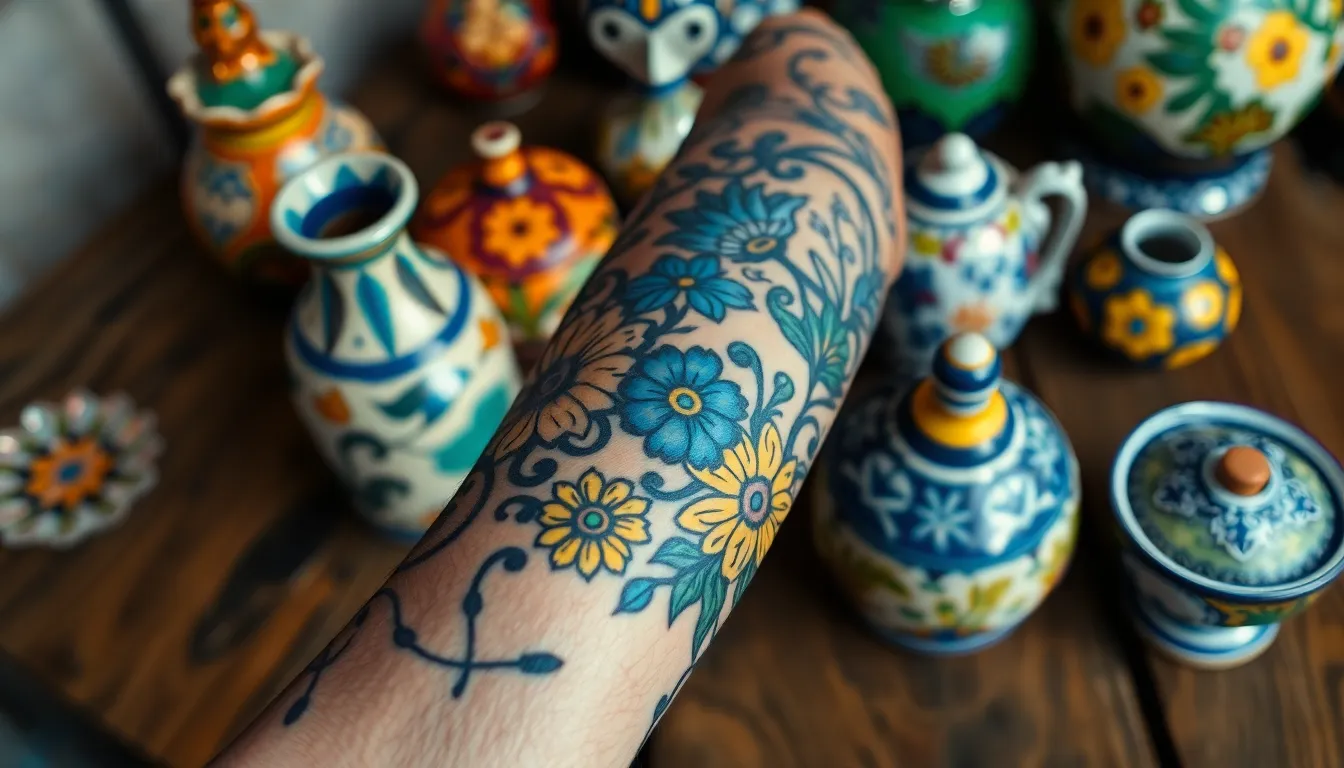
Traditional Mexican folk art offers a vibrant canvas of cultural expression that translates beautifully into masculine tattoo designs. We’re exploring distinctive artistic traditions that celebrate Mexico’s rich heritage through colorful patterns and meaningful symbols.
Talavera Pottery Pattern Tattoos
Talavera patterns bring centuries of Mexican craftsmanship to life through intricate floral and geometric designs. Originating from Puebla, Mexico, these tattoos feature bright blue, yellow, and green patterns set against white backgrounds that create stunning visual contrast. Artists adapt these ornamental motifs into sleeve tattoos or large format pieces to showcase the detailed tile work that makes Talavera pottery famous.
We see these designs working exceptionally well as wraparound pieces that mimic the circular patterns found on traditional pottery. Bold floral arrangements cascade across arms or legs, while geometric borders frame larger tattoo compositions. Men often choose these patterns to honor Mexican craftsmanship while creating unique body art that stands apart from typical tribal designs.
Mexican Tile and Ceramic Motifs
Mexican tile designs feature bold geometric and floral patterns that reflect the architectural beauty of colonial Mexico. These motifs appear in churches, homes, and historical buildings throughout the country, creating repeated patterns with striking color combinations. Tattoo artists translate these designs into body art that captures the essence of Mexican architectural heritage.
Geometric patterns work particularly well for men seeking structured, masculine designs that tell cultural stories. We’ve observed these tattoos incorporating traditional tile arrangements that create visual rhythm across larger body areas. Artists often use bold colors to replicate the vibrancy of authentic Mexican ceramics, though black and gray versions offer equally compelling alternatives.
Papel Picado Banner Designs
Papel picado represents the elaborate paper cutout banners that grace Mexican festivities and celebrations. These tattoo designs feature intricate lace patterns with symbolic cutouts including skulls, flowers, and religious icons that create delicate yet meaningful body art. Artists capture the flowing, banner quality of papel picado through curved lines and detailed negative space work.
We find these designs particularly effective for men wanting to celebrate Mexican traditions like Día de los Muertos through elegant, ornamental tattoos. Banner style compositions work well across chest pieces or as connecting elements between other Mexican themed tattoos. The intricate cutout patterns translate beautifully into tattoo art, creating depth and visual interest that honors the craftsmanship of traditional papel picado artisans.
Chicano Style Lettering and Script Tattoos
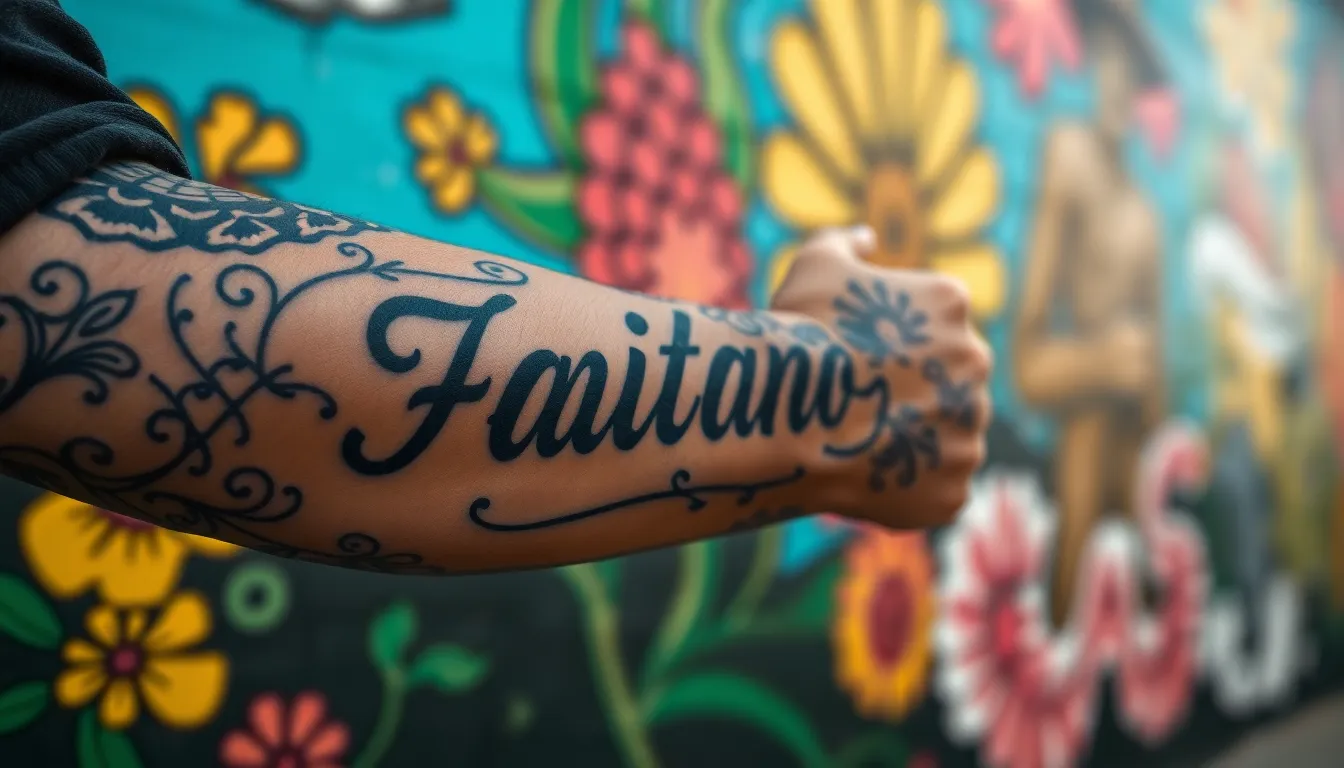
Chicano style lettering emerged from the Mexican American movement of the 1960s and 70s, creating a distinctive tattoo art form that celebrates cultural identity through intricate script work. This tattooing style features finely detailed black and gray shading with elaborate flowing script that transforms meaningful words into powerful visual statements.
Old English Font Mexican Phrases
Old English font dominates Mexican tattoo culture for its bold gothic appearance that commands attention on any body placement. Men frequently choose this timeless lettering style to display Spanish phrases that honor their heritage, with popular selections including “Mi Familia” (My Family), “Viva La Raza” (Long Live the Race), and “Orgullo Mexicano” (Mexican Pride).
The striking contrast of Old English characters makes these tattoos readable from a distance while maintaining their cultural significance. Phrases like “Sangre de Guerrero” (Blood of a Warrior) and “Corazón de León” (Heart of a Lion) showcase masculine strength through traditional Mexican values. Tattoo artists often incorporate decorative flourishes around the lettering to enhance the overall composition.
Popular placement areas for Old English Mexican phrases include the chest, forearms, and upper back where the bold lettering can be displayed prominently. These tattoos serve as permanent declarations of cultural identity that resonate with both the wearer and their community.
Script Writing with Cultural Sayings
Script tattoos featuring Mexican cultural sayings blend elegant calligraphy with profound wisdom passed down through generations. Traditional proverbs like “El que persevera, alcanza” (He who perseveres, achieves) and “Dios aprieta pero no ahoga” (God squeezes but doesn’t strangle) become artistic expressions of life philosophy.
Flowing script styles harmonize beautifully with the rhythmic nature of Spanish language, creating tattoos that appear almost like handwritten poetry on the skin. Artists often use varying line weights and connecting strokes to emphasize the organic flow of these meaningful phrases. Religious sayings such as “En Dios Confiamos” (In God We Trust) and “Bendiciones de Arriba” (Blessings from Above) reflect the deep spiritual connection in Mexican culture.
The intricate curves and loops of script lettering allow for creative integration with other tattoo elements like roses, crosses, or architectural details. These cultural sayings transform personal values into permanent reminders of heritage and belief systems.
Family Names in Traditional Calligraphy
Family names rendered in traditional calligraphy styles represent the cornerstone of Mexican tattoo culture, honoring bloodlines and ancestral connections. Chicano and Old English fonts serve as the primary choices for these deeply personal tributes, with surnames often becoming centerpiece elements in larger tattoo compositions.
Traditional calligraphy techniques emphasize the flowing connection between letters, creating surnames that appear as unified artistic statements rather than individual characters. Artists frequently incorporate decorative elements like banners, scrollwork, or religious imagery to frame family names and enhance their visual impact. Common placements include the upper chest, shoulder blades, and inner forearms where these important names can be prominently displayed.
Multi generational family trees often feature several names in coordinated calligraphy styles, creating comprehensive tributes to entire lineages. These tattoos frequently blend with portrait work, religious imagery, or cultural symbols to tell complete family stories through body art. The permanent nature of these name tattoos reinforces the unbreakable bonds of family loyalty that define Mexican cultural values.
Nature and Animal Symbols from Mexican Culture
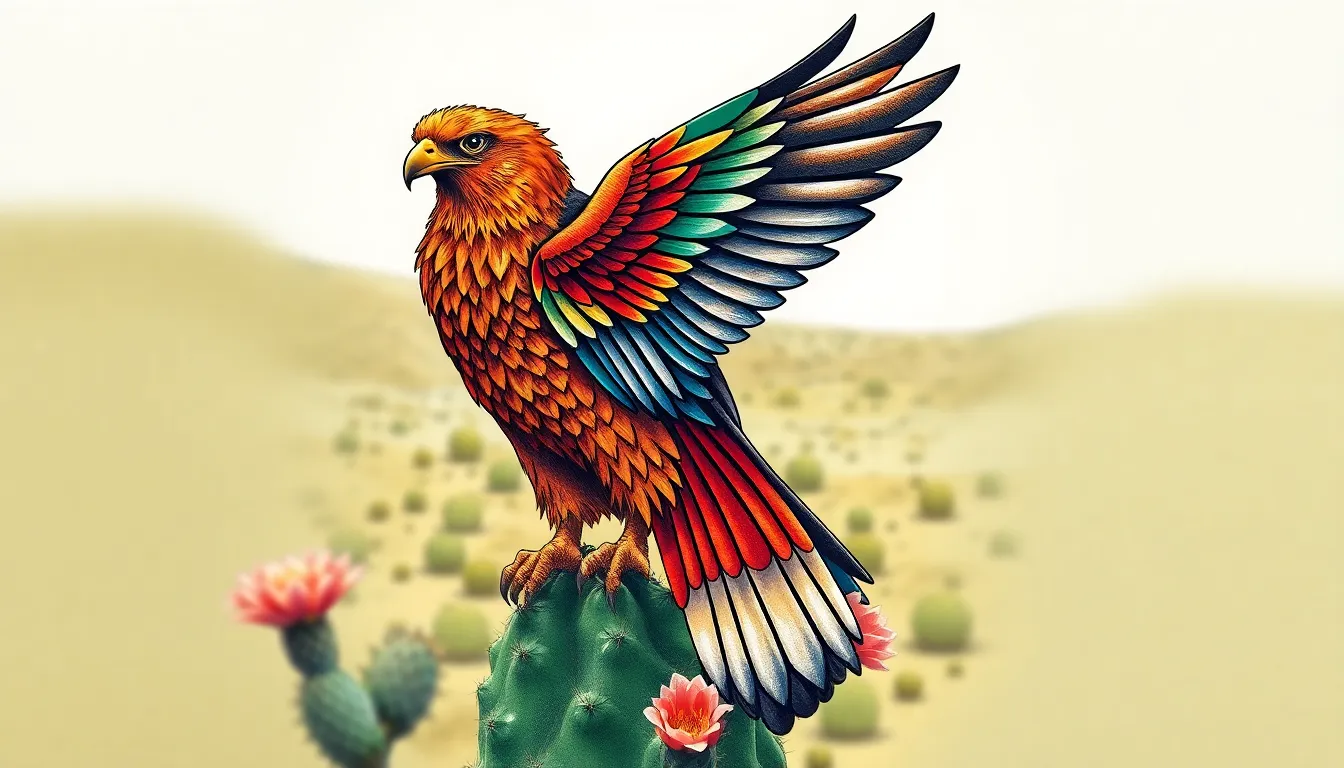
Mexican men often choose tattoos that honor their country’s diverse ecosystems and wildlife, creating powerful connections to the natural industry that defines much of Mexico’s industry and identity.
Mexican Golden Eagle Representations
Mexican golden eagle tattoos serve as the ultimate symbol of national pride and strength in Mexican tattoo culture. We see these majestic birds depicted in their most iconic pose perched on a cactus with a serpent gripped in their powerful talons, directly referencing the foundational legend of Tenochtitlán and the imagery from Mexico’s national flag. These designs capture the eagle’s fierce independence and embody the courage that defines Mexican heritage.
Artists typically render golden eagle tattoos in two distinct approaches: hyper-realistic portrayals that showcase every feather detail and bold traditional interpretations that emphasize symbolic power over anatomical precision. Black and grey versions create dramatic contrast and timeless appeal, while full-color pieces bring the eagle’s natural golden plumage to vibrant life. We recommend larger placements like the chest, back, or upper arm to accommodate the intricate details that make these tattoos truly spectacular.
The spiritual significance of golden eagle tattoos extends beyond national symbolism, representing personal transformation and the ability to soar above life’s challenges. Many men combine eagle imagery with Aztec geometric patterns or incorporate desert elements to create comprehensive Mexican heritage pieces.
Desert Industry and Cactus Scenes
Desert industry tattoos capture the raw beauty and resilience of Mexico’s arid regions, featuring iconic flora like towering saguaro cacti, sprawling agave plants, and endless horizon lines. These designs symbolize endurance and adaptation, qualities that resonate deeply with men who’ve overcome adversity or connect with their Mexican roots. We often see these tattoos spanning forearms or wrapping around legs to accommodate the horizontal nature of desert vistas.
Cactus scenes work exceptionally well as standalone pieces or background elements in larger Mexican-themed compositions. Artists frequently incorporate blooming prickly pear cacti, barrel cacti, and century plants to create authentic representations of Mexico’s Sonoran and Chihuahuan desert ecosystems. The natural textures and organic shapes provide excellent opportunities for shading techniques that bring dimensional realism to the skin.
Contemporary interpretations blend traditional desert imagery with modern artistic elements, sometimes incorporating geometric patterns that echo pre-Hispanic art or sunset color palettes that transition from warm oranges to deep purples. These tattoos celebrate Mexico’s natural heritage while acknowledging the harsh beauty that shapes Mexican character and identity.
Monarch Butterfly Migration Themes
Monarch butterfly tattoos honor one of nature’s most remarkable phenomena that directly connects to Mexican territory each winter. These incredible insects travel thousands of miles to reach the oyamel fir forests of central Mexico, creating a natural spectacle that Mexicans have celebrated for generations. We see monarch designs that capture both individual butterflies in stunning detail and swirling migrations that seem to dance across the skin.
The symbolic meaning of monarch butterflies encompasses transformation, endurance, and the cyclical nature of life and death. Their distinctive orange and black wing patterns provide natural color schemes that translate beautifully into tattoo art, whether rendered in realistic detail or stylized interpretations. Many men choose monarch tattoos to represent personal journeys, family connections to Mexico, or spiritual beliefs about life’s continuous cycles.
Artists often combine monarch butterflies with other Mexican elements like marigolds, sugar skulls, or desert landscapes to create comprehensive cultural narratives. Flight patterns and wing positioning allow for ever-changing compositions that flow naturally with body contours, making these tattoos particularly effective on arms, shoulders, and across the chest where movement can be suggested through artistic placement.
Religious and Spiritual Mexican Tattoo Concepts
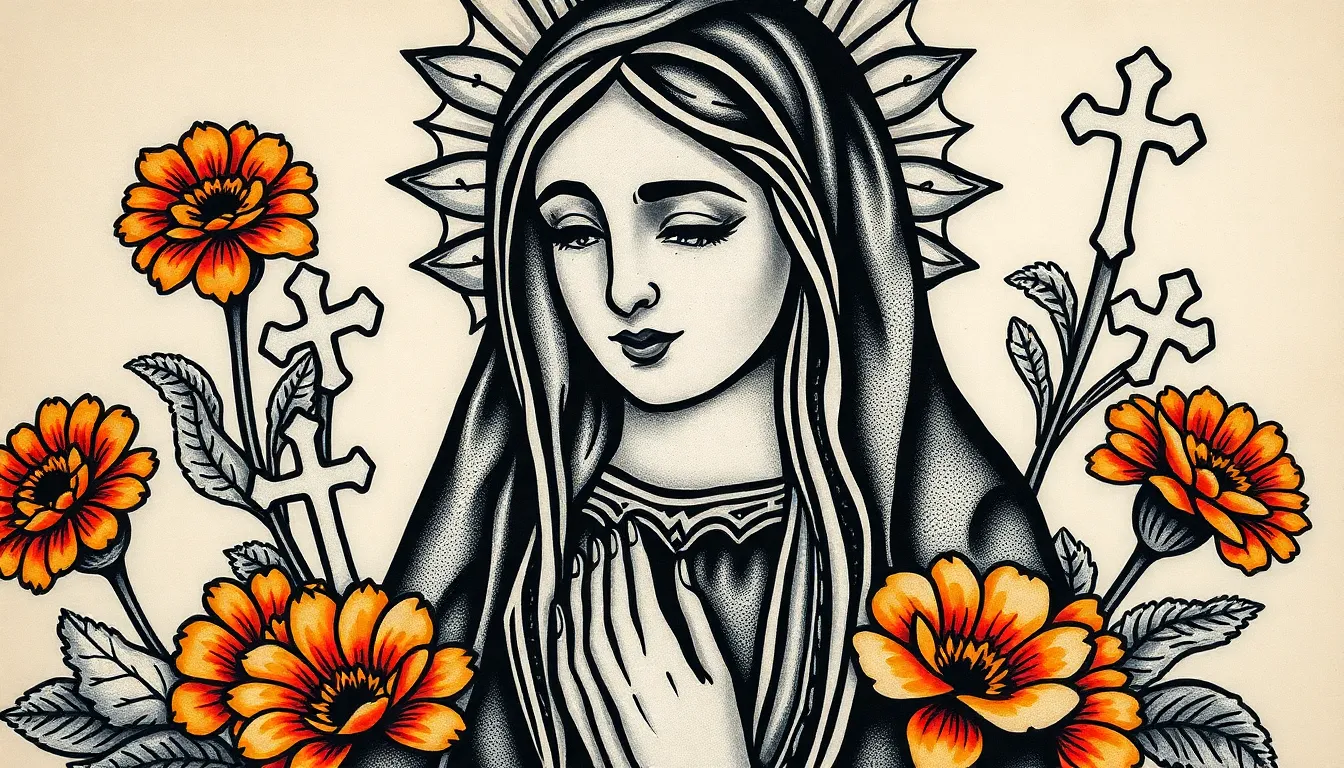
Mexico’s spiritual heritage creates some of the most meaningful tattoo designs available today. These sacred symbols blend Catholic traditions with indigenous beliefs to form powerful expressions of faith and cultural identity.
Catholic Saints and Religious Imagery
Virgin of Guadalupe portraits dominate Mexican religious tattoo art as the most revered spiritual symbol in Mexican culture. Artists typically render these designs using black and grey shading techniques that capture every intricate detail of her sacred image. We recommend chest or back placements for full portraits since these areas provide sufficient space for the fine detail work these tattoos require.
Saint Michael the Archangel tattoos represent protection and spiritual warfare through dramatic imagery of the winged warrior. Tattoo artists often depict him wielding his sword while standing over defeated demons. These designs work exceptionally well as sleeve pieces where the flowing robes and extended wings can be fully appreciated.
Saint Jude designs appeal to men seeking hope during difficult times since he’s known as the patron saint of lost causes. Traditional representations show him holding a flame or medallion while wearing apostolic robes. Most clients choose realistic portrait styles that emphasize his compassionate facial expressions.
Sacred Heart imagery combines Catholic symbolism with bold visual impact through designs featuring thorns, flames, and radiating light. These tattoos often incorporate roses, crosses, or prayer beads to enhance their spiritual significance. Artists frequently use fine line work to capture the intricate details of the thorns and flame patterns.
Indigenous Spiritual Symbols
Aztec calendar stone tattoos showcase the sophisticated understanding of cosmic cycles and time that ancient civilizations possessed. These circular designs feature intricate carvings that represent different gods, time periods, and celestial movements. We suggest larger placements like the back or chest since these detailed symbols lose their impact when scaled down too small.
Quetzalcoatl representations honor the feathered serpent deity through flowing designs that combine serpentine bodies with elaborate featherwork. Artists use bold line work to define the serpent’s coils while adding fine details to individual feathers. These tattoos often wrap around arms or legs to emphasize the serpent’s natural movement.
Aztec warrior designs celebrate the elite military classes through powerful imagery of eagle and jaguar warriors. Eagle warriors typically feature elaborate headdresses with real feathers and fierce expressions that convey strength and honor. Jaguar warriors emphasize stealth and hunting prowess through spotted patterns and predatory poses.
Mayan geometric patterns reflect advanced mathematical precision through complex interlocking designs that form sacred symbols. These patterns often incorporate step pyramids, celestial symbols, and hieroglyphic elements that tell spiritual stories. Modern interpretations blend traditional motifs with contemporary tattoo techniques for striking visual effects.
Prayer Hands with Mexican Elements
Rosary enhanced prayer hands combine traditional Catholic imagery with distinctly Mexican decorative elements like marigold flowers and crosses. Artists often surround the clasped hands with flowing rosary beads that incorporate small crosses or religious medals. These designs work particularly well on forearms where the vertical composition follows the natural arm contours.
Sugar skull accented prayer hands blend Day of the Dead traditions with spiritual devotion through intricate decorative patterns surrounding the hands. Marigold flowers, which are traditional Dia de los Muertos offerings, frame the hands while small sugar skulls add cultural context. We recommend these designs for men who want to honor deceased family members while expressing their faith.
Aztec motif prayer combinations merge Catholic prayer imagery with indigenous symbols like geometric patterns or eagle feathers. These hybrid designs represent the blending of Spanish colonial influence with native Mexican spirituality. Artists typically use the prayer hands as a central focal point while adding Aztec elements as decorative borders or background patterns.
Memorial prayer hand designs incorporate exact Mexican cultural elements like cempasúchil flowers, papel picado banners, or family names in traditional script. These personalized tattoos honor both faith and family heritage through carefully chosen symbolic elements. Most clients add dates or meaningful phrases in Spanish to enhance the personal significance of these spiritual tattoos.
Modern Mexican Street Art and Graffiti Styles
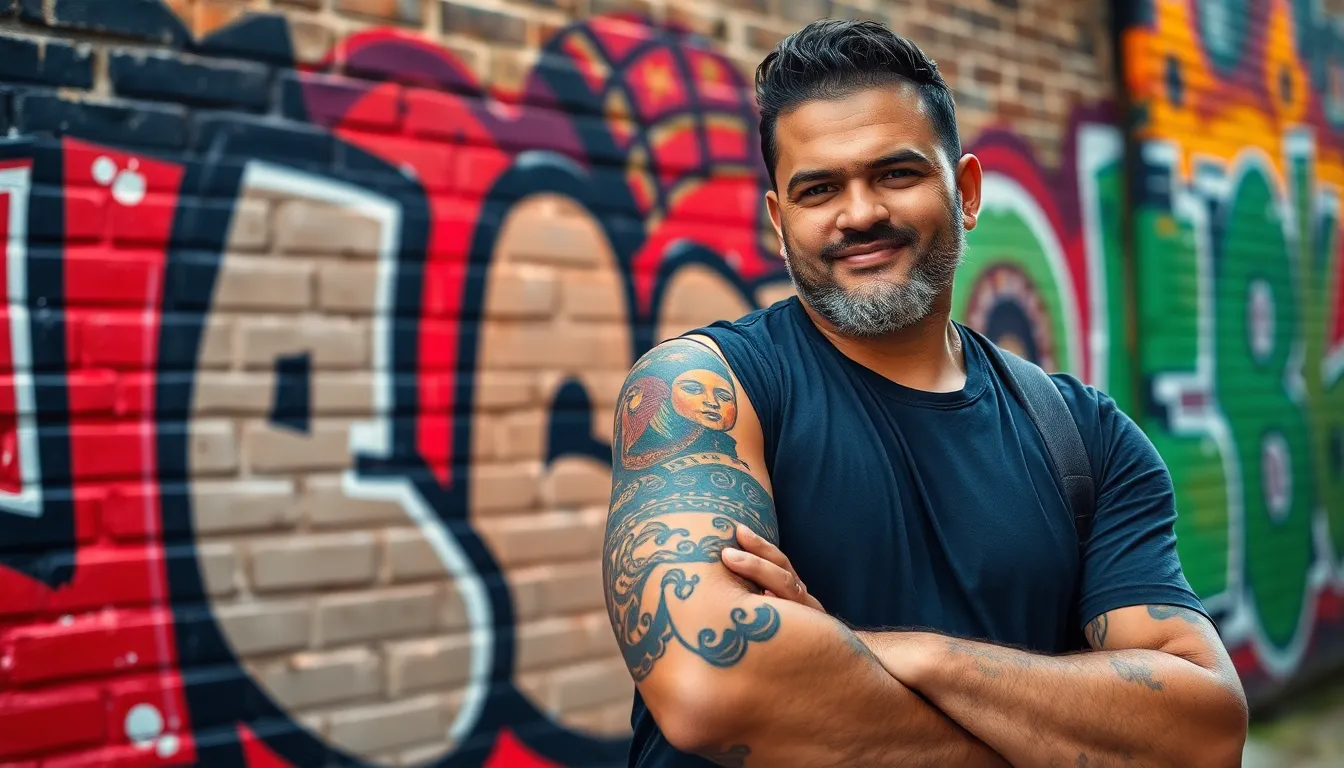
Modern Mexican street art transforms traditional cultural symbols into bold, contemporary expressions that make stunning tattoo designs. We see these vibrant urban aesthetics bringing Mexico’s lively city culture directly onto skin through ever-changing lines and bright colors.
Muralist Inspired Tattoo Designs
Muralist inspired tattoos draw from Mexico’s legendary artists like Diego Rivera and David Alfaro Siqueiros, creating large scale narrative pieces on the body. These designs capture the dramatic, socially conscious artwork that defines Mexican public muralism through illustrative techniques and powerful storytelling elements.
Indigenous people portraits become central focal points in these tattoos, rendered with the same attention to detail and cultural respect found in traditional murals. Historical scenes unfold across shoulders and backs, depicting pivotal moments in Mexican history through bold artistic interpretation.
Cultural symbols integrate seamlessly into these muralist designs, combining traditional iconography with modern artistic techniques. We often see these tattoos featuring multiple narrative elements that tell comprehensive stories about Mexican heritage and identity.
Contemporary Mexican Art Influences
Contemporary Mexican art influences create unique tattoo designs that blend traditional motifs with modern artistic vision. Abstract shapes merge with indigenous patterns, producing personalized pieces that honor cultural heritage while embracing artistic innovation.
Reinterpretations of classic Mexican icons appear frequently in these contemporary designs, transforming familiar symbols into fresh artistic expressions. Modern Mexican artists inspire these tattoos by demonstrating how traditional elements can evolve while maintaining their cultural significance.
Personalized designs emerge from this contemporary approach, allowing men to express their individual connection to Mexican culture through customized artistic elements. These tattoos often feature unexpected combinations of traditional and modern motifs that create truly unique body art.
Urban Culture and Lowrider Aesthetics
Urban culture and lowrider aesthetics represent the powerful Chicano heritage that emerged in the 1940s and 1950s as a form of cultural expression. Car imagery dominates these designs, featuring detailed lowrider vehicles that symbolize Mexican American pride and craftsmanship.
Pin up girls appear alongside religious iconography in these tattoos, creating compositions that celebrate both sensuality and spirituality within Chicano culture. Script lettering plays a crucial role in lowrider tattoos, often featuring family names or meaningful phrases in elaborate calligraphy styles.
Identity themes resonate strongly in lowrider aesthetics, with tattoos serving as visual declarations of Mexican American heritage and community belonging. Family and resilience concepts weave throughout these designs, reflecting the core values that define lowrider culture.
Gang symbolism has evolved into powerful self expression within Mexican American communities, transforming from street identification into artistic celebration of cultural identity. These tattoos now represent personal empowerment and community pride rather than territorial marking.
Placement Ideas for Mexican Tattoo Designs on Men
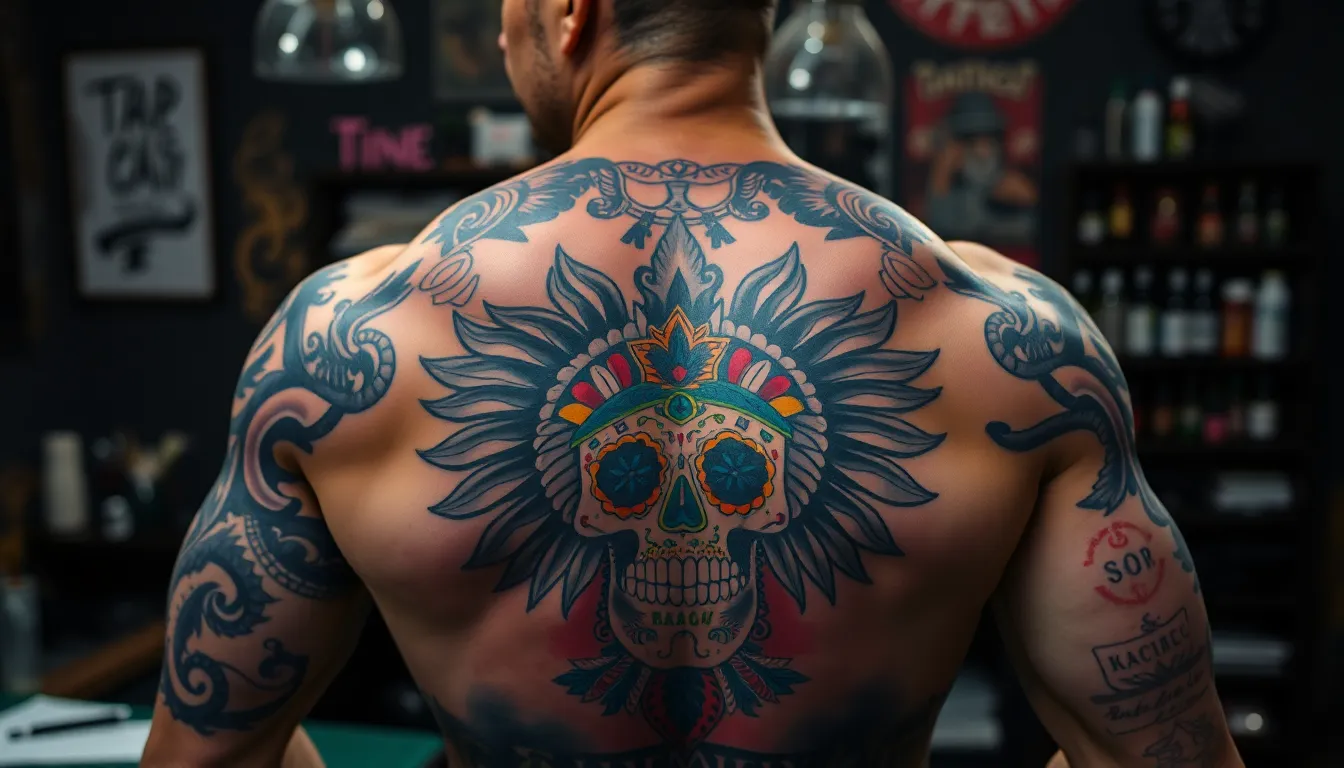
Choosing the right placement transforms your Mexican tattoo from artwork into a powerful statement of cultural identity and personal expression.
Large Back Pieces for Detailed Scenes
Back tattoos offer the ultimate canvas for intricate Mexican cultural storytelling through expansive designs. Your entire back becomes a gallery space where detailed Aztec gods, warriors, and mythological elements can unfold with breathtaking complexity and vibrant colors.
Epic sugar skull compositions flourish across this broad surface, allowing artists to incorporate fine linework, shading, and colorful decorative elements that smaller placements simply can’t accommodate. Traditional Mexican scenery depicting ancient temples, ceremonial scenes, or Day of the Dead celebrations creates stunning visual narratives that showcase your heritage with bold artistic impact.
Complex Aztec calendar stones and feathered serpent designs reach their full potential on back pieces, where every intricate detail and symbolic element receives proper attention and space to breathe.
Sleeve Tattoos with Mexican Themes
Sleeve tattoos excel at weaving multiple Mexican elements into cohesive cultural stories that flow from shoulder to wrist. Your arm becomes a continuous narrative canvas showcasing Aztec patterns, Chicano lettering, Mexican flag imagery, and religious icons in seamless harmony.
Full sleeves allow you to combine different cultural periods and themes, transitioning from ancient Aztec symbols on your upper arm to modern Chicano art near your wrist. Half sleeves focus attention on exact elements like sugar skulls or luchador masks while maintaining visual impact and cultural significance.
Upper arm and shoulder placements prove especially popular for Mexican style tattoos, where bold lines and vibrant colors create striking focal points that complement existing artwork or stand powerfully alone.
Chest and Shoulder Placement Options
Chest tattoos provide prominent positioning for meaningful Mexican symbols and portraits that hold deep personal significance. This placement works exceptionally well for Aztec gods, cultural emblems, or Virgin of Guadalupe designs that deserve front and center attention.
Shoulder tattoos offer versatility for powerful patterns that can extend into sleeve work or remain as standalone statement pieces highlighting masculinity and heritage. The rounded shoulder surface complements circular Aztec motifs and sun stone designs while providing excellent visibility.
Both chest and shoulder placements accommodate medium to large designs that balance detailed artwork with bold visual impact, making them ideal for men who want their Mexican tattoos to command attention and respect.
Conclusion
Mexican tattoo designs offer an incredible journey through centuries of rich cultural heritage and artistic expression. We’ve explored how these powerful symbols connect modern men to ancient traditions while creating deeply personal statements of identity and pride.
From the intricate geometry of Aztec warriors to the vibrant celebrations of Día de los Muertos these tattoos transcend mere decoration. They become living narratives that honor ancestors celebrate resilience and showcase the enduring spirit of Mexican culture.
Whether you’re drawn to the spiritual symbolism of Quetzalcoatl the patriotic power of national emblems or the contemporary edge of street art-inspired designs there’s a Mexican tattoo that speaks to your story. The key lies in choosing artists who understand the cultural significance and can bring authentic detail to your chosen design.
These tattoos aren’t just ink on skin—they’re bridges connecting past and present culture and individual expression tradition and personal transformation.
Frequently Asked Questions
What makes Mexican tattoos culturally significant?
Mexican tattoos honor centuries of rich cultural heritage, combining ancient Aztec and Mayan symbolism with modern artistic expression. They represent deep spiritual meanings, family connections, and national pride while serving as powerful storytelling mediums that connect wearers to their ancestral roots and traditions.
What are the most popular traditional Mexican tattoo designs?
Popular designs include Aztec warriors and eagle symbols, Mayan geometric patterns, Day of the Dead skulls and sugar skulls, Quetzalcoatl (feathered serpent), Virgin of Guadalupe, and national symbols like the Mexican eagle perched on cactus. Each design carries specific cultural and spiritual significance.
What do Day of the Dead tattoos symbolize?
Day of the Dead tattoos celebrate the connection between life and death, honoring deceased loved ones. Sugar skulls feature intricate decorations and bright colors, while calavera portraits blend realistic faces with skull imagery, creating meaningful memorial pieces that reflect Mexican cultural traditions.
Are there modern interpretations of Mexican tattoo designs?
Yes, contemporary Mexican tattoos blend traditional symbols with modern street art, muralist styles, and Chicano culture. Artists incorporate lowrider aesthetics, graffiti elements, and urban culture while maintaining cultural authenticity, creating personalized designs that honor heritage with contemporary artistic vision.
What’s the best placement for Mexican tattoo designs on men?
Large back pieces work best for intricate Aztec or Mayan designs, while sleeves allow for cohesive narratives combining multiple elements. Chest placements highlight meaningful portraits or religious symbols, and shoulders showcase warrior or eagle designs effectively, enhancing cultural significance through proper positioning.
Do Mexican tattoos require specific artistic expertise?
Yes, authentic Mexican tattoos require artists experienced in cultural symbolism, traditional imagery, and specific techniques like black and gray realism for portraits. Artists should understand the cultural significance behind designs and specialize in detailed geometric patterns, religious iconography, or Chicano art styles.
